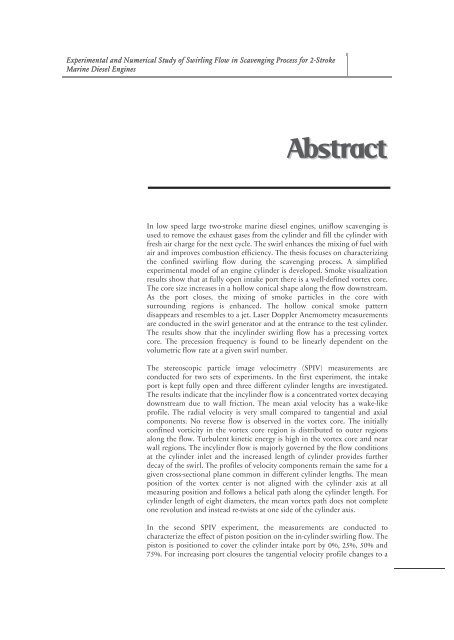Experimental and Numerical Study of Swirling ... - Solid Mechanics
Experimental and Numerical Study of Swirling ... - Solid Mechanics
Experimental and Numerical Study of Swirling ... - Solid Mechanics
You also want an ePaper? Increase the reach of your titles
YUMPU automatically turns print PDFs into web optimized ePapers that Google loves.
<strong>Experimental</strong> <strong>and</strong> <strong>Numerical</strong> <strong>Study</strong> <strong>of</strong> <strong>Swirling</strong> Flow in Scavenging Process for 2-Stroke<br />
Marine Diesel Engines<br />
Abstract<br />
In low speed large two-stroke marine diesel engines, uniflow scavenging is<br />
used to remove the exhaust gases from the cylinder <strong>and</strong> fill the cylinder with<br />
fresh air charge for the next cycle. The swirl enhances the mixing <strong>of</strong> fuel with<br />
air <strong>and</strong> improves combustion efficiency. The thesis focuses on characterizing<br />
the confined swirling flow during the scavenging process. A simplified<br />
experimental model <strong>of</strong> an engine cylinder is developed. Smoke visualization<br />
results show that at fully open intake port there is a well-defined vortex core.<br />
The core size increases in a hollow conical shape along the flow downstream.<br />
As the port closes, the mixing <strong>of</strong> smoke particles in the core with<br />
surrounding regions is enhanced. The hollow conical smoke pattern<br />
disappears <strong>and</strong> resembles to a jet. Laser Doppler Anemometry measurements<br />
are conducted in the swirl generator <strong>and</strong> at the entrance to the test cylinder.<br />
The results show that the incylinder swirling flow has a precessing vortex<br />
core. The precession frequency is found to be linearly dependent on the<br />
volumetric flow rate at a given swirl number.<br />
The stereoscopic particle image velocimetry (SPIV) measurements are<br />
conducted for two sets <strong>of</strong> experiments. In the first experiment, the intake<br />
port is kept fully open <strong>and</strong> three different cylinder lengths are investigated.<br />
The results indicate that the incylinder flow is a concentrated vortex decaying<br />
downstream due to wall friction. The mean axial velocity has a wake-like<br />
pr<strong>of</strong>ile. The radial velocity is very small compared to tangential <strong>and</strong> axial<br />
components. No reverse flow is observed in the vortex core. The initially<br />
confined vorticity in the vortex core region is distributed to outer regions<br />
along the flow. Turbulent kinetic energy is high in the vortex core <strong>and</strong> near<br />
wall regions. The incylinder flow is majorly governed by the flow conditions<br />
at the cylinder inlet <strong>and</strong> the increased length <strong>of</strong> cylinder provides further<br />
decay <strong>of</strong> the swirl. The pr<strong>of</strong>iles <strong>of</strong> velocity components remain the same for a<br />
given cross-sectional plane common in different cylinder lengths. The mean<br />
position <strong>of</strong> the vortex center is not aligned with the cylinder axis at all<br />
measuring position <strong>and</strong> follows a helical path along the cylinder length. For<br />
cylinder length <strong>of</strong> eight diameters, the mean vortex path does not complete<br />
one revolution <strong>and</strong> instead re-twists at one side <strong>of</strong> the cylinder axis.<br />
In the second SPIV experiment, the measurements are conducted to<br />
characterize the effect <strong>of</strong> piston position on the in-cylinder swirling flow. The<br />
piston is positioned to cover the cylinder intake port by 0%, 25%, 50% <strong>and</strong><br />
75%. For increasing port closures the tangential velocity pr<strong>of</strong>ile changes to a
















